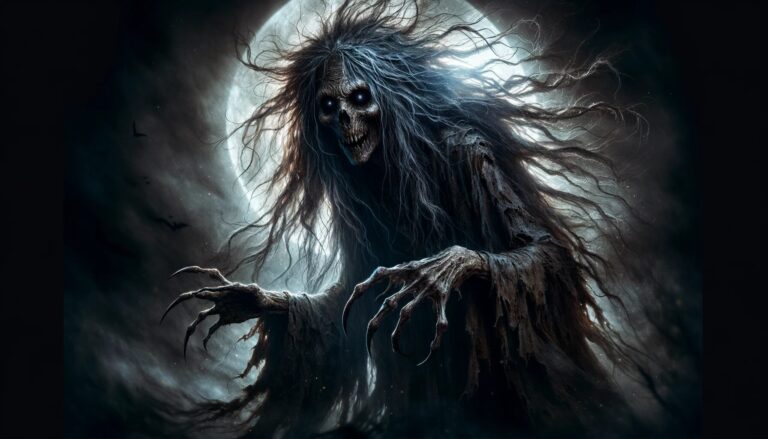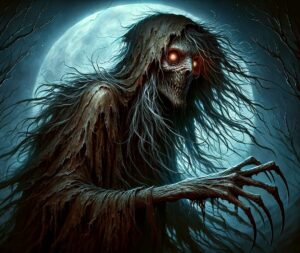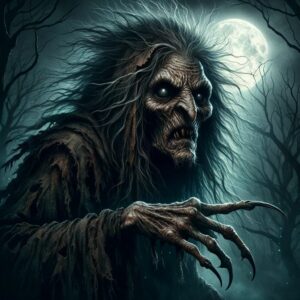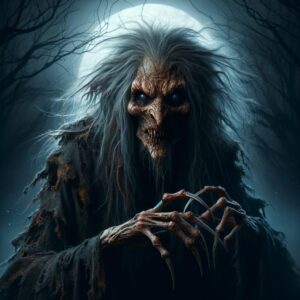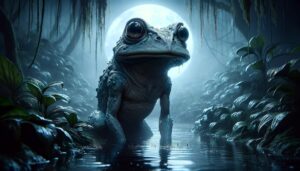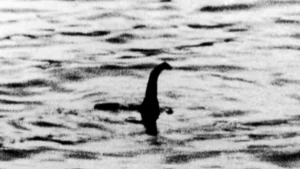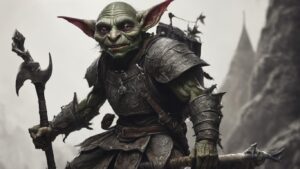Table of Contents
The concept of the Night Hag, or similar malevolent nocturnal entities, has deep historical and cross-cultural roots in human mythology and folklore. While it’s challenging to pinpoint a single origin for the Night Hag, these supernatural beings have appeared in various forms in the mythologies of different cultures for centuries.
One potential source of inspiration for the Night Hag archetype may be the universal human experience of sleep paralysis and vivid nightmares. These frightening and disorienting experiences have likely led to the creation of myths and legends to explain them. As a result, Night Hags and similar entities have been woven into the fabric of folklore worldwide.
Specific cultural interpretations of Night Hags can be traced back to ancient times and are often tied to specific beliefs, customs, and local legends within those cultures. As a result, the origins of Night Hags can be found in the collective imagination of humanity, evolving and adapting to different cultural contexts over time.
The physical description of a Night Hag can vary depending on cultural and regional interpretations, but there are some common features often associated with these malevolent beings:
Withered Appearance: Night Hags are typically depicted as old and haggard women with a decrepit, withered appearance. They may have emaciated or skeletal features, emphasizing their age and malevolence.
Long, Bony Fingers: Night Hags are often described as having long, bony fingers or sharp claws. These fingers may be used to harm or harass their victims, and they add to the eerie and unsettling image of the creature.
Dark or Tattered Clothing: Night Hags are often portrayed wearing dark, tattered, or ragged clothing that further contributes to their ominous appearance. The clothing may be associated with death or mourning.
Unusual Eyes: In some depictions, Night Hags may have unnatural or glowing eyes that can pierce through the darkness. These eyes are often seen as a sign of their supernatural nature and malevolent intent.
Shapeshifting Abilities: In certain mythologies, Night Hags are believed to have the ability to shapeshift, allowing them to take on various forms, including animals or other frightening creatures, to carry out their nocturnal activities.
Heightened Features: Some descriptions emphasize exaggerated or grotesque facial features, such as elongated noses, sharp teeth, or distorted mouths, further adding to the nightmarish quality of Night Hags.
Cloaked in Shadows: Night Hags are often associated with darkness and shadow, and they may appear as shadowy figures that blend seamlessly with the night, making them even more elusive and terrifying.
Personality
The personality traits and characteristics attributed to Night Hags in mythology and folklore typically portray them as malevolent and sinister beings. Some common personality traits associated with Night Hags:
Malevolence: Night Hags are generally considered malicious and evil entities. They are often believed to harbor ill will towards humans and delight in causing fear, discomfort, and suffering.
Cruelty: Night Hags are known for their cruel and sadistic nature. They are thought to take pleasure in tormenting and terrorizing their victims, whether through nightmares, sleep disturbances, or other unsettling experiences.
Deceptiveness: Night Hags are often associated with deception and trickery. They may employ tactics to confuse or manipulate their victims, making it difficult for them to distinguish between reality and the supernatural.
Stealth and Elusiveness: Night Hags are believed to operate in the cover of darkness and often strike when their victims are vulnerable during sleep. They are elusive and difficult to confront directly.
Persistence: Night Hags are sometimes thought to be persistent in their efforts to harm or harass their victims. They may return night after night, creating a sense of ongoing dread and unease.
Malefic Intent: In some cultures, Night Hags are believed to have a specific malefic purpose, such as stealing a person’s soul or life force during sleep paralysis.
Shapeshifting: In certain mythologies, Night Hags are attributed with shapeshifting abilities, allowing them to take on various forms and disguises, making them even more adept at carrying out their malevolent activities.
Night Hags, in various mythologies and folklore traditions, are often believed to possess special abilities and powers that contribute to their malevolent nature. These abilities can vary depending on the cultural and regional interpretations of Night Hags, but some common special abilities associated with them include:
Sleep Paralysis Induction: Night Hags are frequently linked to the phenomenon of sleep paralysis, and one of their primary abilities is believed to be the ability to induce this state in their victims. During sleep paralysis, individuals experience temporary paralysis, making them unable to move or speak while they are conscious and often accompanied by hallucinations.
Nightmares: Night Hags are often considered responsible for causing terrifying nightmares. These nightmares can be vivid, surreal, and emotionally distressing, contributing to the overall sense of dread associated with Night Hags.
Psychic or Magical Attacks: In some traditions, Night Hags are believed to possess psychic or magical abilities that allow them to harm or influence their victims. This could include causing physical pain, illness, or psychological distress.
Shape-Shifting: In certain mythologies, Night Hags are thought to have the power to shape-shift or transform into various forms. This ability enables them to infiltrate homes and torment their victims in different ways.
Invisibility: Night Hags may have the power to become invisible or ethereal, making them difficult to detect and confront. This invisibility adds to their mysterious and elusive nature.
Hypnotic or Mesmeric Abilities: Night Hags may be believed to possess the ability to mesmerize or hypnotize their victims, lulling them into a trance-like state before inflicting harm or causing nightmares.
Flying or Astral Projection: Some interpretations of Night Hags suggest that they can fly or engage in astral projection, allowing them to travel to their victims’ bedrooms and carry out their malevolent deeds.
Darkness Manipulation: Night Hags are often associated with darkness and may have the ability to manipulate or control shadows, using them to obscure their presence or terrify their victims.
In Modern Usage and Symbolism
In modern usage and symbolism, the concept of the Night Hag has evolved beyond its traditional mythological and folklore origins, taking on various interpretations and meanings. While it may not be as prevalent in contemporary culture as in the past, the Night Hag archetype continues to influence art, literature, and popular culture in several ways:
Sleep Disorders: In a medical context, the term “night hag” is sometimes used colloquially to describe the phenomenon of sleep paralysis, a condition where individuals experience temporary paralysis while waking up or falling asleep, often accompanied by vivid hallucinations. This usage reflects the enduring association between Night Hags and sleep disturbances.
Horror and Fantasy Literature: Night Hags and similar supernatural entities are common themes in horror and fantasy literature. They serve as inspiration for authors, filmmakers, and artists who explore the darker aspects of the human psyche. These beings may appear as villains or antagonists in contemporary stories, adding an element of fear and suspense.
Psychological Symbolism: The Night Hag can also be seen as a symbolic representation of inner fears, anxieties, or psychological struggles that individuals face during moments of vulnerability or emotional turmoil. In this sense, the Night Hag represents the shadowy aspects of the human mind.
Moreover, some modern interpretations of the Night Hag archetype involve feminist perspectives. These interpretations view the Night Hag as a symbol of female power and agency, challenging traditional gender roles and expectations. Consequently, this interpretation reclaims and empowers the character of the Night Hag.
Furthermore, in the realm of art and visual media, contemporary artists and visual creators often draw on the imagery of Night Hags. They incorporate it into their works to evoke themes of darkness, nightmares, and psychological depth. These representations frequently explore the stark contrast between beauty and ugliness.
Additionally, the term “Night Hag” can be used metaphorically to describe any oppressive or malevolent force or obstacle in one’s life. It symbolizes challenges or hardships that haunt individuals or societies, causing distress and fear.
In the realm of popular culture, Night Hags and similar supernatural beings continue to make appearances in various forms of entertainment. These include movies, television shows, video games, and graphic novels. They are strategically used to create suspense, horror, and intrigue in storytelling.
Relations and similar creatures
In mythology, folklore, and various cultural traditions, Night Hags and similar creatures are often associated with the idea of malevolent spirits or supernatural beings that visit people during the night to cause fear and disturbance. Some of them related or similar creatures from different cultures and traditions:
Succubus and Incubus: These are malevolent spirits found in Western folklore. Succubi are female demons that seduce men in their sleep, while incubi are their male counterparts who seduce women. They are often associated with sexual nightmares and sleep disturbances.
Old Hag: Similar to the Night Hag, the Old Hag is a term used in English-speaking folklore to describe a malevolent spirit or witch that sits on the chest of a sleeping person, causing sleep paralysis and terrifying dreams.
Mara: In Icelandic folklore, the Mara (or Mare) is a nocturnal spirit believed to sit on the chests of people, causing nightmares and sleep paralysis. This entity shares similarities with the Night Hag.
Lilith: In Jewish folklore, Lilith is often depicted as a malevolent spirit or demon who preys on men during sleep and childbirth. She is sometimes associated with nighttime disturbances and nightmares.
Bangungot: In Filipino folklore, the Bangungot is a creature believed to cause sudden and unexplained deaths during sleep. It is often depicted as a malevolent spirit that appears at night.
Muma Pădurii: In Romanian folklore, the Muma Pădurii is a supernatural entity associated with forests and night terrors. It is sometimes depicted as a witch-like figure that torments travelers and wanderers.
Nightmares: While not a specific entity, nightmares themselves are a common theme in folklore and mythology. Various cultures have their own interpretations of nightmares, often attributing them to malevolent spirits or supernatural beings.
Sleep Demons: In some cultures, there is a belief in sleep demons or night demons that visit people during their sleep to cause disturbances and nightmares. These entities are often considered malevolent and are associated with nighttime fears.
Sleep Paralysis Entities: Across different cultures, there are various entities associated with sleep paralysis experiences. These entities are often described as shadowy figures, demons, or intruders who are believed to be responsible for the sleep paralysis phenomenon.
FAQ
What is a Night Hag?
A Night Hag is a malevolent supernatural being associated with nightmares and sleep disturbances.
What are some common physical traits of Night Hags?
Common physical traits include a withered appearance, long bony fingers, and dark or tattered clothing.
In which cultures are Night Hags or similar entities found?
Night Hags can be found in various cultures' folklore, including Icelandic, Filipino, and African traditions.
What is sleep paralysis, and how is it related to Night Hags?
Sleep paralysis is a condition where a person is temporarily unable to move while falling asleep or waking up, often accompanied by hallucinations. Night Hags are often associated with inducing sleep paralysis.
Are Night Hags real?
No, Night Hags are mythological and folkloric creatures and are not considered real in a scientific sense.
How are Night Hags portrayed in modern literature and pop culture?
In modern literature and pop culture, Night Hags are often depicted as malevolent beings that haunt dreams and create fear and suspense.
What protective measures are taken against Night Hags in some cultures?
Protective measures may include wearing amulets, reciting prayers, or performing rituals before bedtime, depending on cultural beliefs.
What psychological symbolism can be associated with Night Hags?
Night Hags can symbolize inner fears, anxieties, and the darker aspects of the human mind in contemporary psychological interpretations.
Do Night Hags possess any special abilities or powers?
Yes, Night Hags are often believed to possess the ability to induce sleep paralysis, cause nightmares, shape-shift, and employ other supernatural powers to disturb sleep.
What is the historical significance of the Night Hag archetype?
The Night Hag archetype reflects humanity's fascination with the mysteries and fears associated with sleep and the night, offering insight into the human experience across different cultures and time periods.
